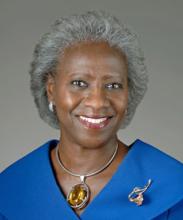
July, 2019
DR. VALANTINE'S FOOD FOR THOUGHT

Hannah A. Valantine, MD Chief Officer for Scientific Workforce Diversity
By now, you know that a key focus of my NIH efforts to advance workforce diversity is confronting sociocultural barriers. These elements can get in the way of establishing and maintaining environments in which scientists from diverse backgrounds thrive in biomedicine. Bias, whether implicit or explicit, is one such major obstacle – as evidenced in this month’s newsletter. Although we can all learn how to recognize and limit our own biases; larger forces are at play. The new SEA Change initiative is one great example of how institutions can fight
sociocultural barriers using systems change approaches. Read on to learn more!
Who, Me? Biased?
Bias is reflected in attitudes or stereotypes that affect our views of others, and they stem from learned experiences. Bias can be overt (explicit), or hidden from our awareness (implicit, as measured by the implicit-attitude test). The human brain uses mental “shortcuts” to make quick decisions that are not always accurate and result in cognitive bias. Nobel laureate Daniel Kahneman’s seminal book, “Thinking Fast and Slow,” articulates this phenomenon as distinct competing neurological systems that reflect automatic vs controlled thinking. These two systems emerge in different settings but can have significant practical implications in our professional lives, as underscored in a recent review showing that gender bias in science remains widespread in student grading, professional hiring, mentoring, tenure, promotion, respect, grant proposal success, and pay. Although many scientists pride themselves on objectivity, few people in any profession, including science, are free of these cognitive biases. Advancing the persistent problem of bias using a research approach is a new paper citing long-term implicit-attitude change and stability across multiple social groups, co-authored by implicit-bias pioneer Mahzarin Banaji.
Want to Be Less Racist? Move to Hawaii
According to psychologist Derald Wing Sue, microaggressions are “subtle snubs, slights, and insults directed toward minorities, as well as to women and other historically stigmatized groups, that implicitly communicate or at least engender hostility.” Such slights – such as asking an non-White scientist “Where are you really from?” – even if unintentional, accumulate over time and stem mainly from implicit biases. Research shows that implicit bias can be reduced through education, and a fascinating recent article explores one scientist’s foray into studying the effects on perception of race from living in a multiracial environment: Hawaii! Check it out.
A SEA Change for Institutions
The new SEA Change (STEM Equity Achievement) initiative aims to expand the STEM talent pool by identifying and removing institutional barriers to diversity, equity, and inclusion. Inspired by the Athena SWAN charter established in the United Kingdom in 2005 to improve gender equity in STEM, the SEA Change initiative differs from diversity programs targeted to individuals. Rather, SEA Change – which is voluntary – gives awards to institutions who conduct a data-based self-assessment to appraise their institutional makeup, policies, and culture and identify knowledge gaps and barriers (and then, develop action plans). The inaugural awardees are Boston University; the University of California, Davis; and the University of Massachusetts Lowell. Congrats!
Diversifying Data Science
Over the past decades, biomedicine has transformed from a mostly observational activity to an intensively informational endeavor, and data science is at the heart of everything modern researchers do today. Data analytics are also vital to healthcare, precision medicine in particular – to make sure treatments and delivered in the right place, in the right amount, and at the right time. Data science is the perfect place for the infusion of new talent, new perspectives, and different ways of thinking: the primary aims of scientific workforce diversity generally. Check out a new private-sector initiative that aims to harness some of this talent through a new consortium of historically black colleges and universities to meet the growing demand for data-analytics experts in science and healthcare.

The links above are pulled from the top news articles trending on the subject of diversity in science and technology.
The stories selected are not a reflection of the views of the National Institutes of Health.

